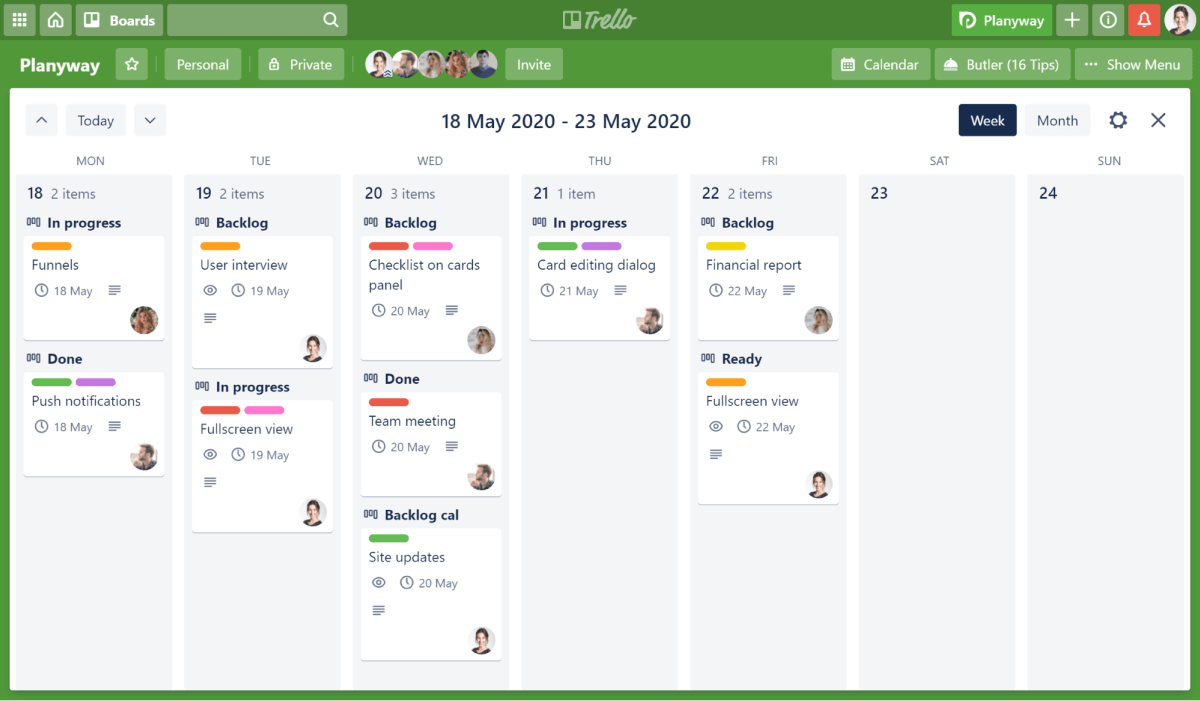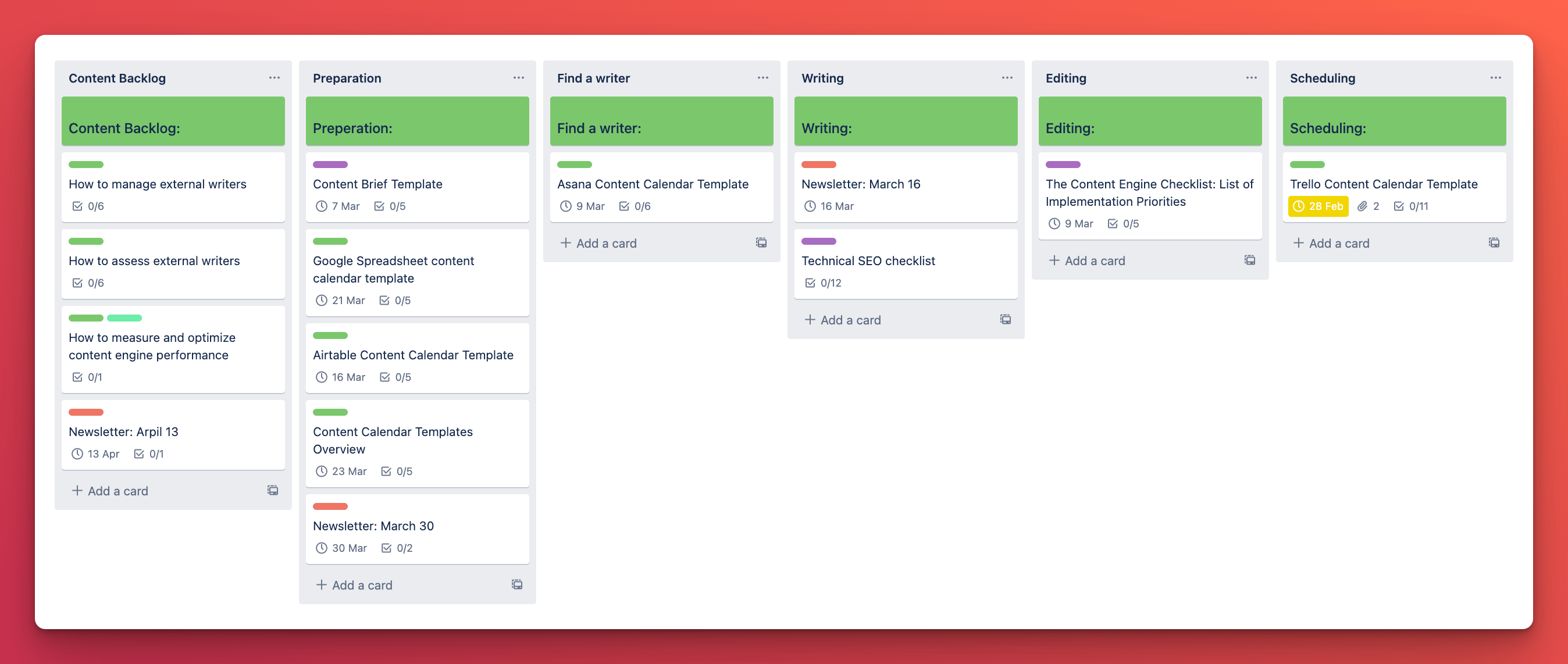Trello
- Boards, Lists, and Cards – Visual Kanban system to organize tasks seamlessly
- Power-Ups – Integrations and enhancements for automation, reporting, and more
- Butler Automation – Rule-based triggers and commands to automate repetitive tasks
- Templates – Pre-built board templates for various workflows and industries
Short Description
Trello is a popular project management and collaboration tool that uses a visual board-based system to organize tasks and workflows. Its simple drag-and-drop interface, powerful integrations, and customizable features make it ideal for teams, freelancers, and businesses managing projects of any size.

Pros
- Intuitive and visual Kanban interface
- Easy team collaboration and sharing
- Powerful integrations with other apps (Slack, Google Drive, etc.)
- Customizable workflows with Power-Ups
- Free plan available with essential features
Cons
- Limited advanced project management features without paid plans
- Can become cluttered with too many cards and boards
- Not ideal for complex multi-project dependencies
Full Description
What is Trello and What Does It Do?
Trello is a powerful, visual project management and collaboration tool that enables individuals and teams to organize tasks, workflows, and projects seamlessly using boards, lists, and cards. It adopts the Kanban methodology to provide a clear overview of what’s being worked on, who’s working on it, and where something is in the process.
Whether you’re managing daily to-dos, editorial calendars, client projects, or complex workflows, Trello makes it intuitive with its drag-and-drop interface, integrations, and automation (powered by Butler).

Key Highlights:
-
Visual task and project management
-
Kanban-style boards and lists
-
Butler automation for repetitive tasks
-
Seamless integrations with over 200+ tools
Who Is Trello Best Suited For?
Trello is designed for teams of any size, freelancers, project managers, marketers, developers, educators, and personal users who need an organized, visual system to manage tasks and projects efficiently. Its intuitive design makes it especially popular among:
-
Small to mid-sized businesses (SMBs)
-
Agile development teams
-
Content creators and marketing teams
-
Educators managing courses or group assignments
-
Individuals tracking personal goals and productivity

Trello’s flexibility and ease of use make it an accessible choice for anyone looking to bring clarity and organization to their work or personal projects.
Main Use Cases and Applications
Here are some of the most common real-world applications of Trello:
-
Project Management:
Plan, track, and manage projects with clear timelines, assigned cards, and progress tracking. -
Content Planning & Editorial Calendars:
Map out blog posts, social media content, and publishing schedules. -
Agile and Sprint Planning:
Use boards to track backlog, current sprint, and completed tasks for development teams. -
Event Planning:
Organize every aspect of an event from guest lists to vendor coordination. -
Personal Productivity:
Manage personal goals, daily tasks, learning plans, or household projects.

Key Benefits and Standout Features
Why Trello Stands Out:
-
Simple, Intuitive Interface:
Easy drag-and-drop Kanban boards with a shallow learning curve for new users. -
Automation with Butler:
Automate repetitive tasks and workflows without coding, saving time and minimizing errors. -
Power-Ups (Integrations):
Extend Trello’s functionality by integrating with tools like Slack, Google Drive, Jira, and more. -
Customizable Boards:
Create boards for any workflow with custom fields, labels, checklists, and due dates. -
Collaboration Features:
Assign members, comment on cards, share attachments, and set notifications to keep everyone aligned. -
Cross-Platform Accessibility:
Use Trello on Web, iOS, Android, and as a desktop app, ensuring seamless access anywhere.

Why Choose Trello Over Other Project Management Tools?
While many project management tools offer robust features, Trello remains a top choice for its simplicity, visual clarity, and adaptability. Unlike complex platforms that require lengthy onboarding, Trello allows teams to get started immediately with minimal setup.
Here’s why Trello is often preferred:
-
No Overhead Complexity:
Ideal for users who prefer visual, straightforward task management without complex Gantt charts or resource management modules. -
Scalability with Simplicity:
From personal to enterprise-level projects, Trello scales up without sacrificing usability. -
Affordable Pricing:
Generous free plan with essential features, making it ideal for freelancers and small teams, with paid plans offering advanced features and admin controls. -
Butler Automation is Included:
Unlike some competitors where automation costs extra, Trello includes Butler automation even in free and lower-tier plans with usage limits.
Real-World Use Case Examples
1. Marketing Team Editorial Calendar
A digital marketing agency uses Trello to plan blog content, social media posts, and email campaigns. Each card contains copy drafts, design attachments, approval checklists, and scheduled publishing dates. This reduces back-and-forth communication and keeps the entire team aligned.

2. Agile Development Sprint Board
A SaaS development team manages their sprint planning with Trello by creating columns for Backlog, To-Do, In Progress, Code Review, and Done. Cards are assigned to developers with deadlines, and Butler automations move cards based on checklists completed.

3. Event Planning Workflow
An events agency plans weddings using Trello boards to track venue selection, vendor bookings, guest RSVPs, and timelines. Shared boards with clients provide transparency and real-time updates without constant emails.
4. Personal Productivity and Goal Tracking
A freelancer uses Trello for managing client projects, tracking invoices, and setting weekly goals. Cards are color-coded by client, with checklists for deliverables and Power-Ups connected to Google Drive for document storage.

Conclusion
Trello remains one of the simplest yet most effective project management tools available today. Its Kanban-style system, automation features, extensive integrations, and adaptability for both team and personal use make it a standout choice. Whether you’re a freelancer planning your week, a marketing team managing content, or a developer running agile sprints, Trello empowers you to organize anything, together.


